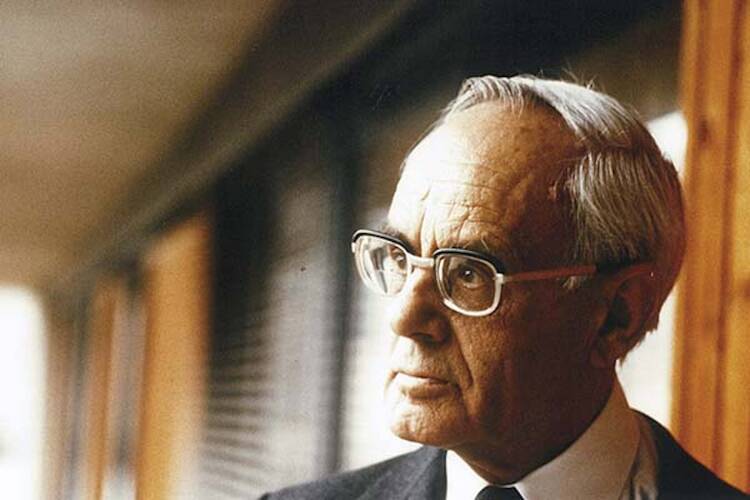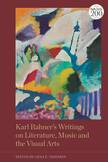Karl Rahner’s theology of The Beatles
Karl Rahner believed that, ideally, the arts should “become an intrinsic moment of theology itself.” Unsurprisingly, the German Jesuit theologian looked to culture as a source for divine illumination.
As a theologian who notably served as an expert at the Second Vatican Council, Rahner’s impact has been momentous and continuous over the past six decades. His published works on church, society and related matters are routinely cited as ranging in the thousands.
T&T Clark
224p $40
A newly available compilation of Rahner’s writings on the arts, edited and translated from the original German by Gesa Thiessen, traces Rahner’s thinking about the phenomenon of inspired enthusiasm: Karl Rahner’s Writings on Literature, Music and the Visual Arts.
In “Religious Enthusiasm and the Experience of Grace” in Theological Investigations (1979), Rahner referred to the Catholic charismatic movement as “mysticism in ordinary dress” and “mysticism of the masses.”
Understanding crowd impulses preoccupied Rahner, as seen in his essay, “What Do the Beatles Sing?” That essay is newly made available in this book; it originated as a preface for a 1968 study and selective translation of Beatles lyrics by Georg Geppert, a student chaplain in Münster. Always concerned about pastoral matters, Rahner abstained from opining about the Beatles or their recordings. Indeed, he generally recused himself from the role of critic, instead expressing interest in the phenomenon of Beatlemania. Witnessing the Beatles’ fervent audience, Rahner observed, is “important for the preacher if he wants to know what today’s people are ‘actually’ like.”
The next logical question: “Should a preacher of God’s Word thus not also get to know the fans of the Beatles if he does not just want to preach to himself and his kind?” Rahner considered the work of understanding contemporary crazes as part of priestly duties. In a recollection published in America in November 2004, Rahner’s friend and student Leo J. O'Donovan, S.J., recalled that when Rahner visited Georgetown University in 1974, he discussed in Latin with his Jesuit hosts the recent American supernatural horror film, “The Exorcist.”
So Geppert’s analysis of Beatles songs, in the wake of John Lennon’s notorious statement to a journalist in 1966 that the Beatles were “more popular than Jesus,” was of secondary importance for Rahner. Instead, Rahner’s eye was on the public response, just as he was visiting the city of Prague in 1969, according to O'Donovan. Rahner walked the streets to “see what kind of food was available in stores for ordinary people.” He would ride escalators in department stores and study shop windows, “endlessly curious about everyday life.”
Delighting in simple pleasures like “roller coasters for their adventure and excitement,” Rahner was possibly less sober-minded than he usually appears in published photos. The website of the Karl-Rahner-Archiv in Munich includes at least one photo of a smiling Rahner brandishing a cigarette debonairly, vaguely resembling the English comedic actor John Le Mesurier.
O'Donovan lauded Rahner’s “towering integrity of mind,” but also informed readers that his mentor favored the “occasional Manhattan (he loved the cherries)” at cocktail hour. Rahner’s occasional whimsical opinion was always leavened with historical points, such as when he told The New York Times in September 1979 that with future church developments, “The Pope might move to the Philippines and have good reason to do so.”
And when asked whether the newly elected Pope John Paul II would be innovative, Rahner informed the Times:
In history, most innovations have come from individuals other than the Pope. Look at St. Francis of Assisi, for example, or St. Catherine of Siena. We have had no great theology from a Pope since Leo the Great. If Popes provide us with inspiration, that is fine, but there are many other Christians we can rely on.
In the essay “Word and Music in Church” (1961), written on the occasion of the local premiere of Igor Stravinsky’s “Mass” (1944-48) at the Jesuit church in Innsbruck, Rahner was again unorthodox as a music writer primarily interested in crowd response. He specified that he did not intend “to endorse Stravinsky as a composer” or interpret the composition musically. Instead, Rahner asked the assembled listeners for “inner sympathy” and an “open heart with which one must approach a work of art, if one wants to understand a new and unfamiliar work by a great human being and master.”
This hoping for receptivity was combined with modesty. A chapter on “The Theology of the Religious Meaning of Images” begins with the caveat: “I do not claim to possess the competence that belongs to an expert in the philosophy or history of art, whether sacred or secular. I understand little about these things. I do not even believe that I belong among those who have more than an average background in these fields.” And in addressing the topic of “Church Building: On Modern Church Architecture,” Rahner readily admitted:
I do not even dare to think of myself as having much understanding of art, taste and similar qualities that one would need to have to engage with some competence in the question of church architecture. On such a question the theologian, who is not even a parish priest, can only say that his theological science is very incompetent in answering the question how a church should look like today.
Rahner’s musings are illuminated by the notion that all the arts, not just literature, may be spiritually inspiring (books naturally acquire precedence because God expressed himself directly in words). Nor must an artwork be ostensibly ecclesiastical in subject to be spiritually elevating. Rahner saw the arts as markers of humanity, just as the Latin term symbolum (creed) refers to a distinctive mark of Christians, a sign or token used for identification—as in the Apostles' Creed, the Symbolum Apostolicum.
Whether discussing music, architecture or literature, Rahner, as his more accessible theological books such as Encounters with Silence and The Great Church Year show, was convinced that culture helps to achieve what he called a “communion anthropology” in The Love of Jesus and the Love of Neighbor.
Love of neighbor as reflected in the arts may convey an “improbable optimism” that it is possible to transcend the “miserable narrow anxiety” of existence and the “banality of everyday life.”
Or, as Gesa Elsbeth Thiessen puts it in this volume, “When a work of art reaches, and is revelatory of, the depths of human existence, it reaches the realm where true religious experience takes place.”











